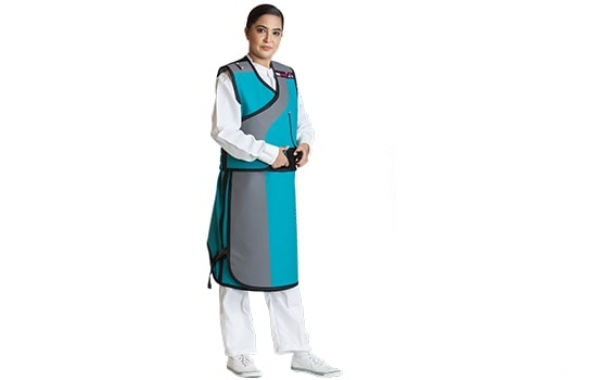Introduction
With advancements in medical imaging and radiation-based treatments, the need for adequate protective gear has never been more critical. Healthcare professionals, radiologists, and industrial workers dealing with radiation exposure must prioritize safety to minimize the risks of prolonged exposure. One of the most effective protective measures against radiation is the use of Radiation Protection Aprons. These aprons, often made with lead or lead-equivalent materials, provide a vital shield against harmful radiation, ensuring safety in environments where exposure is inevitable.
Understanding Radiation and Its Risks
Radiation, particularly ionizing radiation, has the potential to cause severe health issues, including genetic mutations, tissue damage, and increased cancer risks. Professionals working in radiology, nuclear medicine, and industrial radiography are at a higher risk of exposure. To mitigate these risks, protective equipment such as lead apron for radiation protection is widely used. These aprons serve as a barrier, absorbing and reducing the penetration of radiation into the body.
The Role of Radiation Protection Aprons
1. Shielding Against Ionizing Radiation
Radiation Protection Aprons are designed to attenuate ionizing radiation, primarily X-rays and gamma rays. The material composition of these aprons plays a crucial role in reducing radiation exposure to sensitive organs, preventing both acute and chronic health issues.
2. Enhancing Workplace Safety
Radiation safety protocols mandate the use of protective aprons in high-exposure areas, such as:
- Hospitals and Diagnostic Centers: Radiologists, technicians, and patients undergoing X-ray imaging or fluoroscopic procedures wear lead apron for radiation protection to minimize radiation exposure.
- Dental Clinics: Dental professionals use protective aprons when performing X-ray diagnostics.
- Nuclear Power Plants: Workers in nuclear facilities require shielding against gamma radiation.
- Industrial Applications: Professionals working with non-destructive testing (NDT) or radiographic inspections use aprons to reduce exposure.
Types of Radiation Protection Aprons
1. Lead-Based Aprons
Lead aprons are the most common type used for radiation protection. They are highly effective in blocking X-rays but tend to be heavy, which may cause discomfort over prolonged usage.
2. Lead-Equivalent Aprons
To counter the weight issue of traditional lead aprons, manufacturers have developed lead-equivalent aprons using composite materials like bismuth, antimony, and tungsten. These offer similar protection with reduced weight, making them more comfortable for extended wear.
3. Disposable Radiation Protection Aprons
Designed for one-time use in specific procedures, these aprons provide lightweight protection and are often used in emergency or temporary setups.
How to Choose the Right Lead Apron for Radiation Protection
Selecting the appropriate apron depends on various factors, including the type of radiation exposure, comfort, and compliance with safety standards. Consider the following when choosing a Radiation Protection Apron:
- Lead Equivalence (mm Pb): The level of protection is determined by the thickness of the lead or lead-equivalent material. Standard protection levels range from 0.25 mm Pb to 0.5 mm Pb.
- Weight and Comfort: Lightweight options are preferable for professionals who wear them for extended durations.
- Style and Coverage: Full-wrap aprons, vest-skirt combinations, and frontal aprons provide different levels of protection based on exposure levels.
- Compliance with Safety Standards: Ensure the apron meets international safety regulations such as ASTM and IEC standards.
Proper Usage and Maintenance of Radiation Protection Aprons
1. Correct Wearing Techniques
- Always wear the apron properly to cover all critical body areas.
- Ensure a snug fit to avoid radiation leaks.
- Use additional protective accessories like thyroid shields for comprehensive coverage.
2. Regular Inspection and Care
- Storage: Store aprons flat or on specialized hangers to prevent cracks in the protective material.
- Cleaning: Use manufacturer-approved disinfectants for cleaning to maintain hygiene and prevent material degradation.
- Periodic Testing: Regularly inspect for wear and tear, and replace aprons that show signs of damage.
Innovations in Radiation Protection Aprons
Recent advancements in radiation safety have led to the development of:
- Lighter Materials: New composite materials reduce the overall weight of aprons while maintaining high levels of protection.
- Ergonomic Designs: Improved designs focus on comfort, reducing strain on healthcare professionals.
- Antimicrobial Coatings: Enhances hygiene, making aprons safer for long-term use.
- Custom-Fitted Aprons: Personalized aprons ensure better fit and improved protection for individuals.
Why Choose Trivitron’s Radiation Protection Aprons?
Trivitron Healthcare is a trusted name in radiation safety, offering a range of high-quality lead apron for radiation protection. Our products are:
- Scientifically Tested: Designed with advanced shielding materials for maximum protection.
- Lightweight and Comfortable: Ensuring ease of use for extended wear.
- Compliant with International Standards: Meeting ASTM, IEC, and other safety regulations.
- Durable and Long-Lasting: Providing high durability for prolonged use.
Explore our range of Radiation Protection Aprons here to ensure your safety against harmful radiation exposure.
Conclusion
Radiation protection is an essential aspect of healthcare and industrial safety. Using high-quality Radiation Protection Aprons significantly reduces radiation exposure, ensuring the well-being of professionals working in high-radiation environments. Investing in the right lead apron for radiation protection not only safeguards health but also enhances workplace safety standards. Trivitron Healthcare remains committed to providing state-of-the-art radiation protection solutions, ensuring a safe and secure working environment for all.



